Learning to make bread from scratch V1 [EN/FR]
Hello Hive! I am subscribed to the Homesteading community for almost a year. In fact, since I bought my land with the cabin, almost day for day.
It had been years that I was watching homesteading videos on YouTube, and it really made me dream.
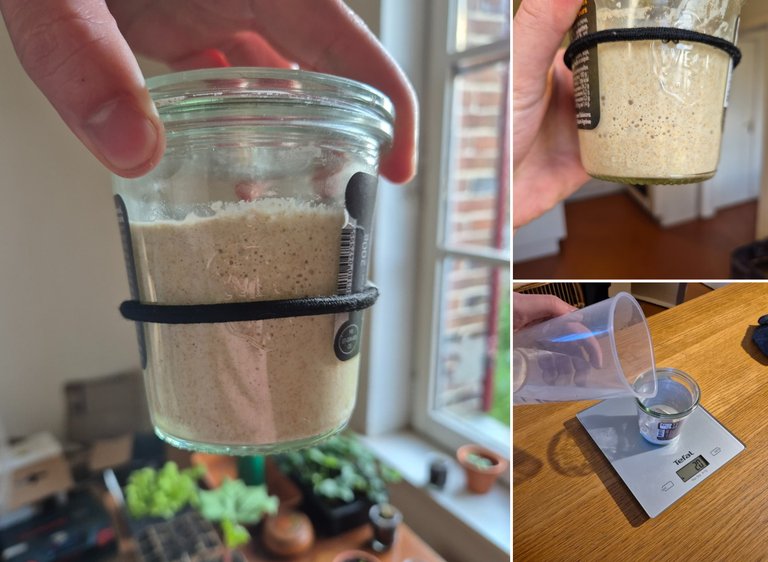
But the truth is that there is a real gap between watching a video quietly lying on your couch… and taking action.
Especially when you have no skill.
So I speak to all the people who post here, that I read, that I upvote and that I comment: bravo!
Bravo for your motivation.
Since we acquired our land, water has flowed under the bridges, and today we live in a country house with a big garden and some abandoned farm buildings.
We are not yet owners, but maybe one day.
And of course, we also keep our land with the cabin.
I am interested more and more in autonomy and homesteading, and little by little, I take action.
I try to gain confidence in myself… and honestly, it feels really good!
Lately, I started to make my own sourdough to make my bread.
And that is what I wanted to share with you today!
Bread, it is a basic food in our lives.
We consume it regularly, and it costs more and more to buy.
So yes, salaries increase… but well.
If you want to limit the impact of inflation on bread, making it yourself remains a good alternative.
You still have to buy the basic ingredients and pay the electricity for the baking, but it always costs less.
It is on this idea that I decided to launch myself in the making of my own sourdough… and therefore of my own bread.
I informed myself a lot, but I can say some nonsense.
Basically, sourdough is a natural fermentation agent.
It allows to make the bread rise without using industrial yeast. And since with @altheana we try to avoid more and more industrial food (with difficulty), it matches our values.
The sourdough works thanks to a living culture of wild yeasts and lactic bacteria that we find naturally in the flour and in the ambient air.
You can get some from a baker, but making it yourself is much more rewarding. And honestly, it is within reach of everyone.
You just need to mix flour (whole or rye preferably, at the beginning) with water. That’s all.
Over the days, the micro-organisms present in the flour and the environment will develop.
To start, I put in a glass jar:
- 20 g of flour
- 20 g of water
It is super simple: you just have to keep a 1:1 ratio between the flour and the water.
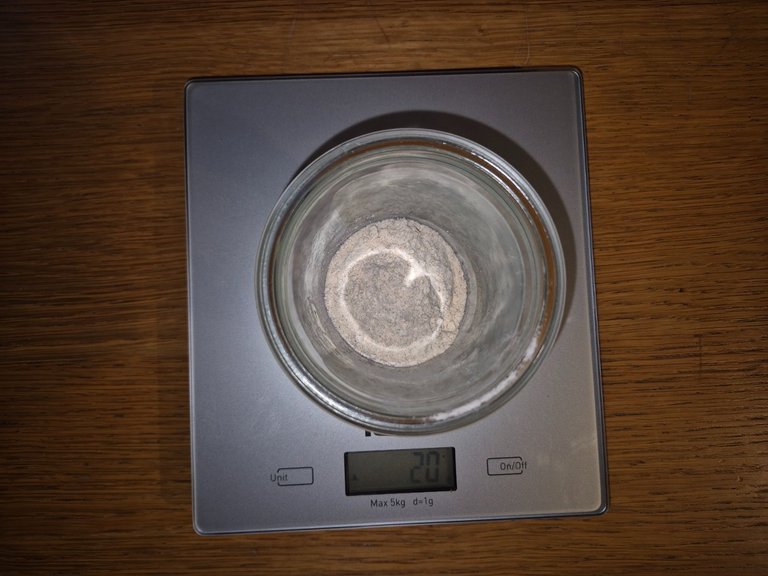
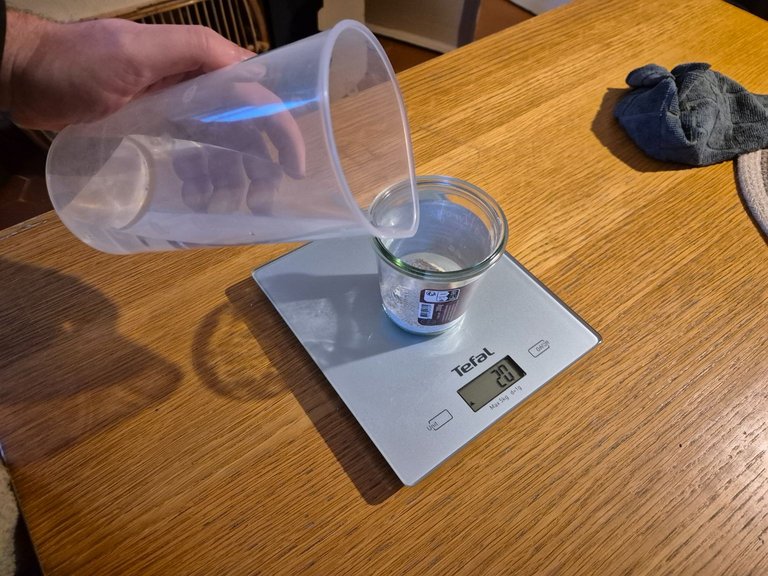
Then, we mix well to remove all the lumps.
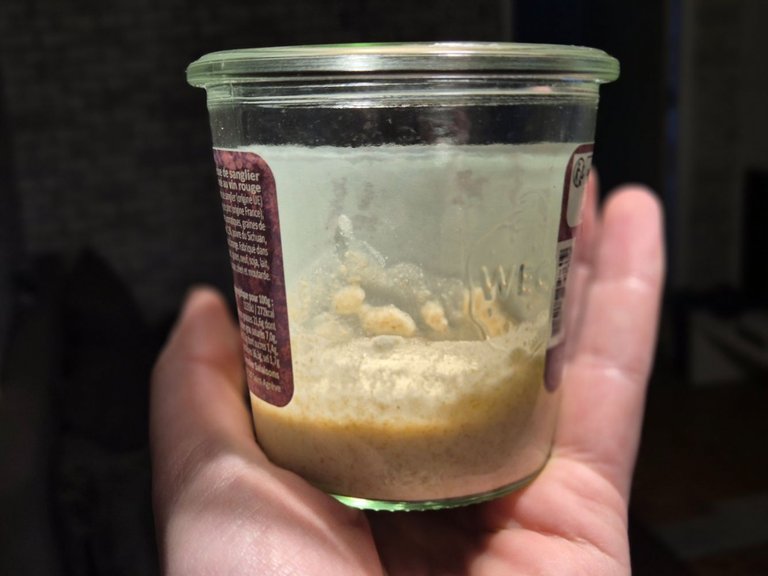
We cover the jar (without closing it hermetically), and we let it at room temperature, around 20°C.
Me, I started at the beginning of spring, in a non-insulated house. It was 16°C at home.
It is not a problem, but it slows down a bit the fermentation.
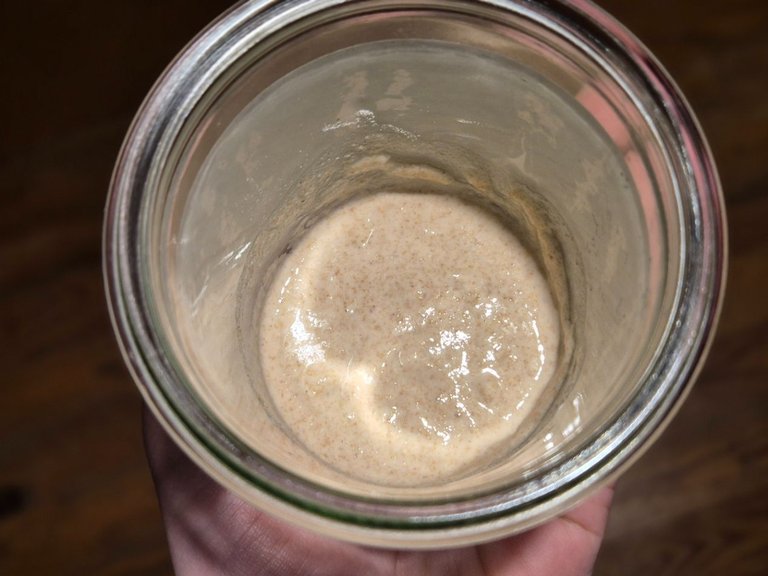
By feeding on the sugars of the flour, the micro-organisms produce carbon dioxide, lactic and acetic acids (even if, to be honest, I did not go further than that in the understanding).
But it is this fermentation that gives the sourdough the capacity to make the dough rise.
After 24h, so the second day, nothing special at home. Some small bubbles on the surface, but nothing crazy.

Still, you have to “refresh” the sourdough, that is to say add flour and water to it, always in 1:1.
As I had 40 g of sourdough (20 g of flour + 20 g of water), I removed 20 g to keep 20 g.
Then I added 20 g of flour and 20 g of water.
The second day, I thus had 60 g of sourdough.
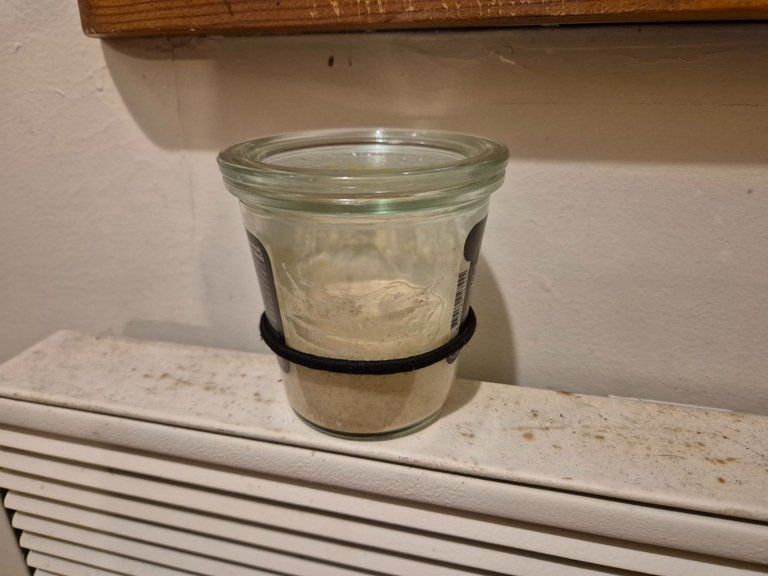
This time, I put an elastic band around the jar to follow the rising.
If the sourdough goes above the elastic after 6 to 8 hours, it means it starts to activate.
Otherwise, no worries: we continue to feed it every day until it doubles or triples in volume.
Every day, I kept 20 g of the sourdough from the day before and added 20 g of flour and 20 g of water.
The rest, I put it aside in a bowl in the fridge, to make crepes, waffles, pancakes, etc.
I followed this ritual for almost 20 days. I had some doubts because the videos I watched to make mine said that it took about 6 to 8 days.
And it is only when the temperatures rose that the sourdough really started to show signs of life.
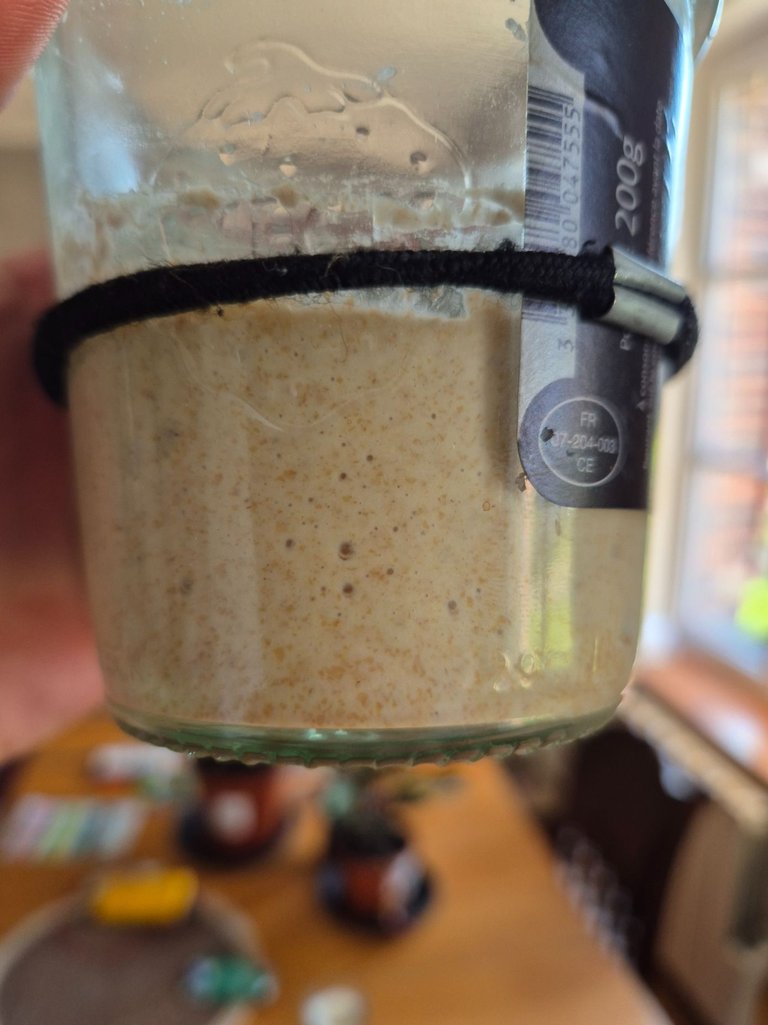
There, I saw lots of bubbles. The brown spots came from my semi-whole flour, not from the fermentation.
I fed it again and I put it in the sun.
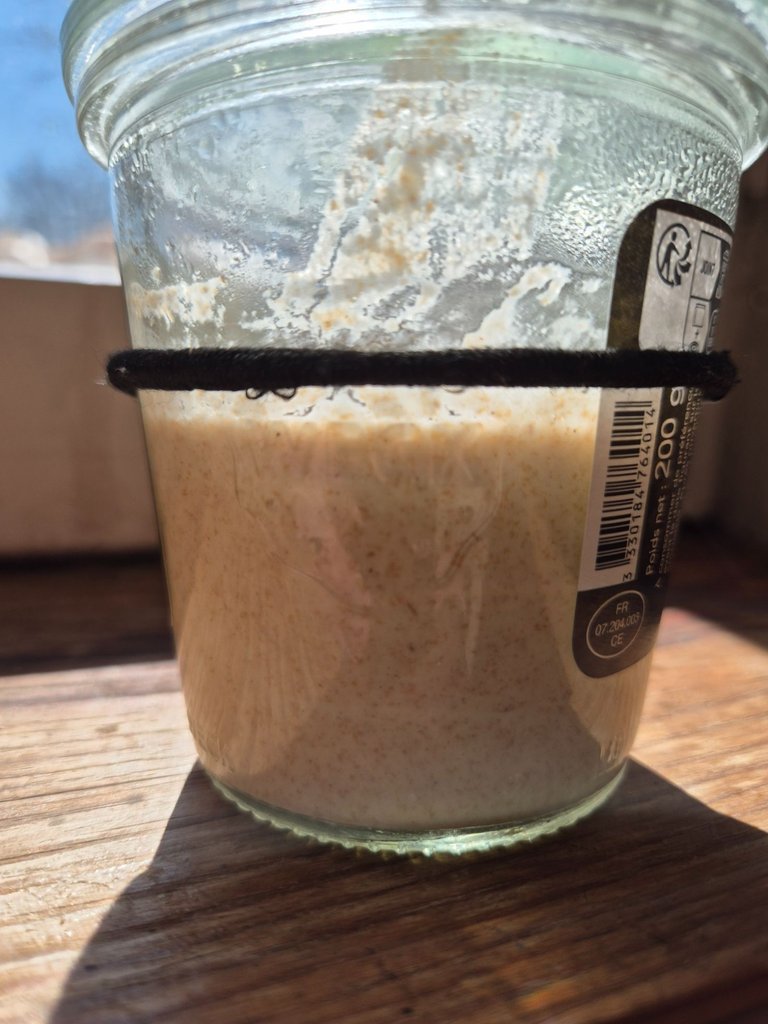
And in barely an hour, it was already showing activity!
I was amazed. My sourdough was finally born.
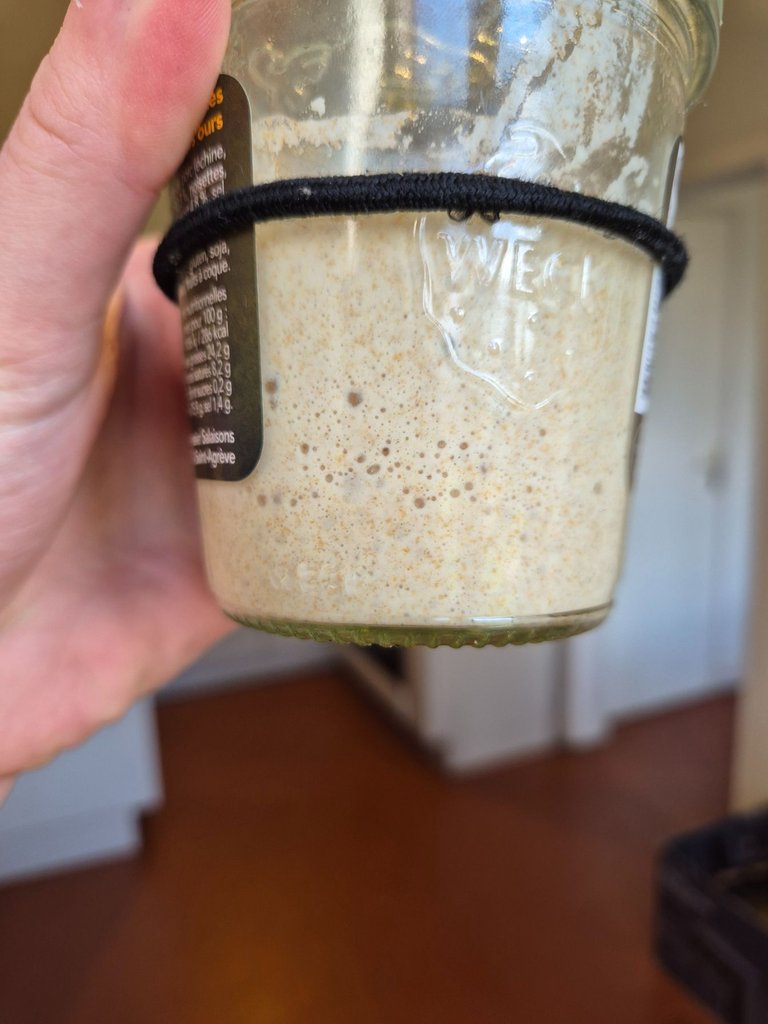
It seems that we must give it a name, since it is a living organism that I will have to take care of every week.
So I named mine Hector.
One hour later, Hector started to rise.

And two hours later, he was at the top of his form.
It is at this moment that you have to use it to make bread.
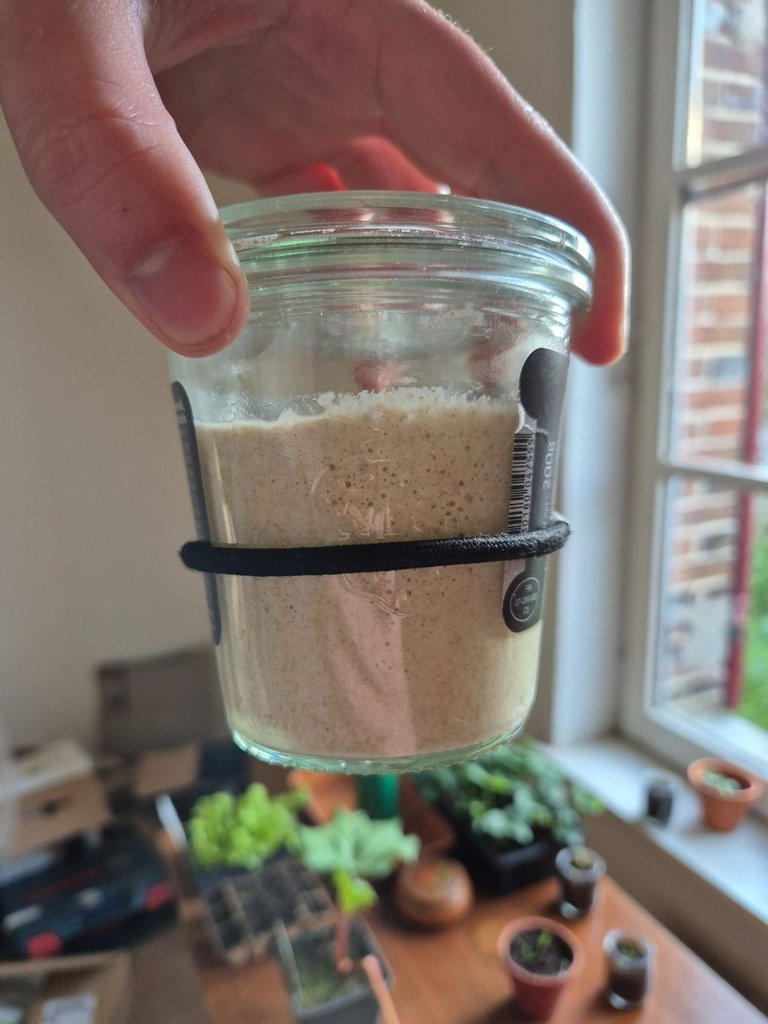
In the evening, it had nothing left to eat and went down again. It is normal.
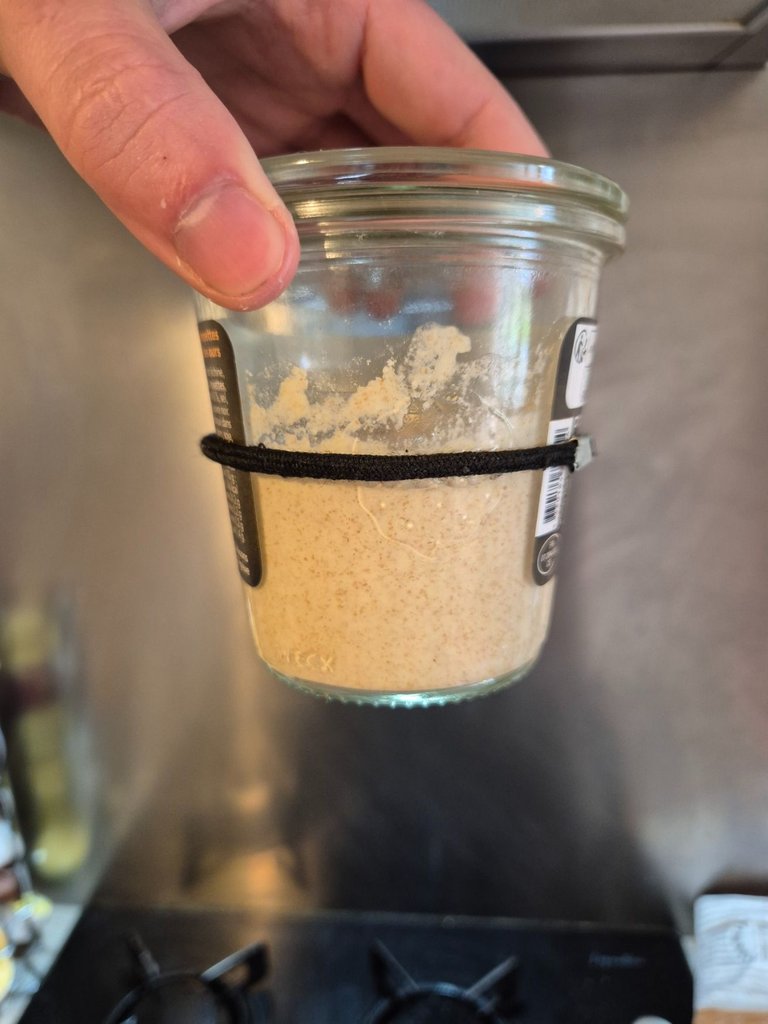
At this stage, two options:
- Feed it every day (always 20 g of sourdough + 20 g flour + 20 g water)
- Feed it one last time, let it rise, then put it in the fridge. The cold stops the fermentation, and you can settle for one feeding per week.
I chose the first solution for three weeks.
But today, I move to the second, because our oven is broken, so I cannot make bread for the moment.
Whatever happens, it is a really satisfying experience.
The hardest is to trust the process and to continue to feed the sourdough every day, even when we do not see visible signs.
Depending on the flour used (the ideal being an organic, whole flour) and the ambient temperature, it can really be long.
Version Française
Bonjour Hive ! Je suis abonné à la communauté Homesteading depuis bientôt un an. En fait, depuis que j’ai acheté mon terrain avec la cabane, presque jour pour jour.
Ça faisait des années que je regardais des vidéos de homesteading sur YouTube, et ça me faisait vraiment rêver.

Mais la vérité, c’est qu’il y a un sacré fossé entre regarder une vidéo tranquillement allongé sur son canapé… et passer à l’action.
Surtout quand on n’a aucune compétence.
Alors je parle à toutes les personnes qui publient ici, que je lis, que j’upvote et que je commente : bravo !
Bravo pour votre motivation.
Depuis qu’on a acquis notre terrain, de l’eau a coulé sous les ponts, et aujourd’hui on vit dans une maison de campagne avec un grand jardin et quelques bâtiments de ferme à l’abandon.
On n’en est pas encore propriétaires, mais peut-être un jour.
Et bien sûr, on garde aussi notre terrain avec la cabane.
Je m’intéresse de plus en plus à l’autonomie et au homesteading, et petit à petit, je passe à l’action.
J’essaie de prendre confiance en moi… et franchement, ça fait un bien fou !
Dernièrement, j’ai commencé à faire mon propre levain pour faire mon pain.
Et c’est ça que je voulais partager avec vous aujourd’hui !
Le pain, c’est un aliment de base dans nos vies.
On en consomme régulièrement, et il coûte de plus en plus cher à l’achat.
Alors oui, les salaires augmentent… mais bon.
Si vous voulez limiter l’impact de l’inflation sur le pain, le faire vous-même reste une bonne alternative.
Il faut quand même acheter les ingrédients de base et payer l’électricité pour la cuisson, mais ça revient toujours moins cher.
C’est sur cette idée-là que j’ai décidé de me lancer dans la fabrication de mon propre levain… et donc de mon propre pain.
Je me suis pas mal renseigné, mais je peux dire quelques bêtises.
En gros, le levain est un agent de fermentation naturel.
Il permet de faire lever le pain sans utiliser de levure industrielle. Et puisqu'avec @altheana on essaie d'éviter de plus en plus les aliments industriels (difficilement), ça correspond à nos valeurs.
Le levain fonctionne grâce à une culture vivante de levures sauvages et de bactéries lactiques qu’on trouve naturellement dans la farine et dans l’air ambiant.
On peut en récupérer auprès d’un boulanger, mais le faire soi-même est beaucoup plus gratifiant. Et franchement, c’est à la portée de tout le monde.
Il suffit de mélanger de la farine (complète ou de seigle de préférence, au début) avec de l’eau. C’est tout.
Au fil des jours, les micro-organismes présents dans la farine et l’environnement vont se développer.
Pour commencer, j’ai mis dans un pot en verre :
- 20 g de farine
- 20 g d’eau
C’est super simple : il suffit de garder un ratio 1:1 entre la farine et l’eau.


Ensuite, on mélange bien pour enlever tous les grumeaux.

On couvre le pot (sans le fermer hermétiquement), et on le laisse à température ambiante, autour de 20°C.
Moi, j’ai commencé au début du printemps, dans une maison pas isolée. Il faisait 16°C chez nous.
C’est pas gênant, mais ça ralentit un peu la fermentation.

En se nourrissant des sucres de la farine, les micro-organismes produisent du dioxyde de carbone, des acides lactiques et acétiques (même si, pour être honnête, je ne suis pas allé plus loin que ça dans la compréhension).
Mais c’est cette fermentation qui donne au levain la capacité de faire lever la pâte.
Au bout de 24h, donc le deuxième jour, rien de spécial chez moi. Quelques petites bulles à la surface, mais rien de fou.

Il faut quand même "rafraîchir" le levain, c’est-à-dire lui ajouter de la farine et de l’eau, toujours en 1:1.
Comme j’avais 40 g de levain (20 g de farine + 20 g d’eau), j’ai retiré 20 g pour en garder 20 g.
Puis j’ai ajouté 20 g de farine et 20 g d’eau.
Le deuxième jour, j’avais donc 60 g de levain.

Cette fois, j’ai mis un élastique autour du pot pour suivre la montée.
Si le levain dépasse l’élastique au bout de 6 à 8 heures, c’est qu’il commence à s’activer.
Sinon, pas grave : on continue à le nourrir chaque jour jusqu’à ce qu’il double ou triple de volume.
Tous les jours, je gardais 20 g du levain de la veille et j’ajoutais 20 g de farine et 20 g d’eau.
Le reste, je le mettais de côté dans un bol au frigo, pour faire des crêpes, des gaufres, des pancakes, etc.
J’ai suivi ce rituel pendant presque 20 jours. J'ai eu quelques doutes car les vidéos que je regardais pour faire le miens disaient que ça prenait environ 6 à 8 jours.
Et c’est seulement quand les températures sont remontées que le levain a vraiment commencé à montrer des signes de vie.

Là, j’ai vu plein de bulles. Les taches brunes venaient de ma farine semi-complète, pas de la fermentation.
Je l’ai nourri à nouveau et je l’ai mis au soleil.

Et en une heure à peine, il montrait déjà de l’activité !
J’étais bluffé. Mon levain était enfin né.

Il paraît qu’il faut lui donner un nom, puisque c’est un organisme vivant dont je vais devoir m’occuper chaque semaine.
Alors j’ai nommé le mien Hector.
Une heure plus tard, Hector commençait à lever.

Et deux heures plus tard, il était au max de sa forme.
C’est à ce moment-là qu’il faut l’utiliser pour faire du pain.

Le soir venu, il n’avait plus rien à manger et est redescendu. C’est normal.

À ce stade, deux options :
- Le nourrir tous les jours (toujours 20 g de levain + 20 g farine + 20 g eau)
- Le nourrir une dernière fois, le laisser monter, puis le mettre au frigo. Le froid stoppe la fermentation, et on peut se contenter d’un seul nourrissage par semaine.
J’ai choisi la première solution pendant trois semaines.
Mais aujourd’hui, je passe à la deuxième, car notre four est en panne, donc je ne peux pas faire de pain pour le moment.
Quoi qu’il en soit, c’est une expérience vraiment satisfaisante.
Le plus dur, c’est de faire confiance au processus et de continuer à nourrir le levain chaque jour, même quand on ne voit pas de signes visibles.
En fonction de la farine utilisée (l’idéal étant une farine bio, complète) et de la température ambiante, ça peut vraiment être long.
The English translation was done using the DeepL API, and the images were taken with my smartphone.

Nice! From couch dreaming to actually baking, that's the spirit! 🍞 Maybe I should try that myself too. 😉
Thanks for reading and commenting! That's very appreciable. I think that making one's own leaven is within everyone's reach and can really improve our resilience 👍
Best of luck with Hector, and its many offspring!
Haha thanks for your comment! I convey the message to him 😅😀
Congratulations @genesisledger! You have completed the following achievement on the Hive blockchain And have been rewarded with New badge(s)
Your next target is to reach 6000 upvotes.
You can view your badges on your board and compare yourself to others in the Ranking
If you no longer want to receive notifications, reply to this comment with the word
STOP!PIZZA
Your post has been manually reviewed for curation by the Principality of Bastion.
Check the Trail of posts we voted
Principality of Bastion - Our Leit Motiv? Let's Grow Together.
Principality's site | Minava NFT Market | Discord | Our Twitch Channel
You may TRAIL this account if you like the curation we do, or join our discord to know more about what we do.

$PIZZA slices delivered:
@itharagaian(7/10) tipped @genesisledger
Come get MOONed!